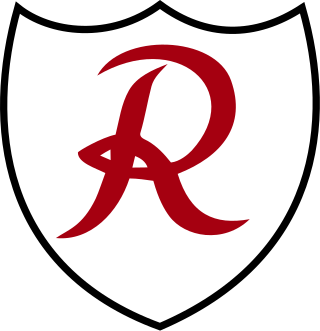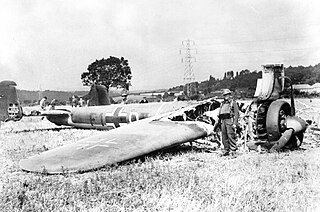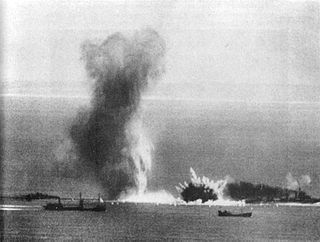
The Battle of Britain was a military campaign of the Second World War, in which the Royal Air Force (RAF) and the Fleet Air Arm (FAA) of the Royal Navy defended the United Kingdom (UK) against large-scale attacks by Nazi Germany's air force, the Luftwaffe. It was the first major military campaign fought entirely by air forces. The British officially recognise the battle's duration as being from 10 July until 31 October 1940, which overlaps the period of large-scale night attacks known as the Blitz, that lasted from 7 September 1940 to 11 May 1941. German historians do not follow this subdivision and regard the battle as a single campaign lasting from July 1940 to May 1941, including the Blitz.
Operation Adler was the code name designated by the Luftwaffe for their air offensive against Great Britain in the summer of 1940. The defensive side of this operation was known as the Battle of Britain. This offensive was part of an ambitious campaign, namely the amphibious invasion of England. The Luftwaffe bore the responsibility of neutralizing the Royal Air Force (RAF) and its capability to thwart the planned invasion. Operational planners were tasked with developing a plan to systematically destroy Great Britain's ability to wage war. This strategic air offensive was only one part of the overall campaign for the eventual invasion of England. The first step in this operation would be attaining air superiority for the invading force. Hermann Göring, the Luftwaffe Commander, violated all seven 'principles of war' as stated in U.S. Army Manual FM 100-5, but still came very close to defeating the RAF. The Luftwaffe's targeting of London was seen by the British as a fatal mistake. Adlertag was the Goring designated code name for the first day of German offensive air operations aimed at destroying the RAF.

Hugo Wilhelm Sperrle was a German military aviator in World War I and a Generalfeldmarschall in the Luftwaffe during World War II.

Jagdgeschwader 2 (JG 2) "Richthofen" was a German fighter wing during World War II. JG 2 operated the Messerschmitt Bf 109 and Focke-Wulf Fw 190 single-seat, single-engine interceptor aircraft.

Operation Flax was an Allied air operation during the Tunisian campaign, as part of the larger North African campaign of the Second World War. Flax was intended to prevent air supply between Italy and the Axis armies in Tunis, Tunisia, in April 1943. An equivalent Allied naval effort was called Operation Retribution.

Jagdgeschwader 26 (JG 26) Schlageter was a German fighter-wing of World War II. It was named after Albert Leo Schlageter, a World War I veteran, Freikorps member, and posthumous Nazi martyr, arrested and executed by the French for sabotage in 1923. The wing fought predominantly against the Western Allies.

Adlertag was the first day of Unternehmen Adlerangriff, an air operation by Nazi Germany's Luftwaffe intended to destroy the British Royal Air Force (RAF). The operation came during the Battle of Britain after Britain rejected all overtures for a negotiated peace with Germany. However, Adlertag and subsequent operations failed to destroy the RAF or gain local air superiority.

Kampfgeschwader 3 "Blitz" (KG 3) was a Luftwaffe bomber wing during World War II.

Battle of Britain Day, 15 September 1940, is the day on which a large-scale aerial battle in the Battle of Britain took place.
During the Second World War the German Luftwaffe was the main support weapon of the German Army (Heer). It fought and supported the Wehrmacht's war effort throughout the six years of conflict and contributed to much of Nazi Germany's early successes in 1939–1942. After the turn in Germany's fortunes, it continued to support the German ground forces until the German surrender in May 1945.

No. 238 Squadron is a squadron of the Royal Air Force. It was first formed in 1918 by combining number 347, 348 and 349 Flights at RAF Cattewater by the Royal Flying Corps during the First World War. It was reformed for the Second World War, the Berlin Airlift and currently is a Line Training Flight (LTF) squadron based at RAF Cosford, albeit in a non-flying capacity. It is among those officially acknowledged Battle of Britain squadrons.
Zerstörergeschwader 76 was a Zerstörergeschwader (wing) of the German Luftwaffe during World War II. The wing operated the Messerschmitt Bf 109 in the early phases of World War II, then the Messerschmitt Bf 110 for the duration of the war.

Zerstörergeschwader 26 "Horst Wessel" was a Luftwaffe heavy fighter wing of World War II.

The Battle of the Heligoland Bight was the first "named" air battle of the Second World War, which began the longest air campaign of the war on 3 September 1939, the Defence of the Reich. After the declaration of war, RAF Bomber Command began operations against Nazi Germany but limited their attacks to those targets that were purely military and had little risk of civilian casualties. This largely limited their efforts to attacks on the Kriegsmarine warships in German ports to prevent their use in the Battle of the Atlantic.

Kampfgeschwader 1 was a German medium bomber wing that operated in the Luftwaffe during World War II.

Zerstörergeschwader 1 was a Luftwaffe zerstörer or ‘destroyer’ wing of World War II.

The Messerschmitt Bf 110, often (erroneously) called Me 110, was a twin-engine heavy fighter in the service of the Luftwaffe during the Second World War. Hermann Göring was a proponent of the Bf 110, and nicknamed it his Eisenseiten ("Ironsides"). Development work on an improved type to replace the Bf 110, the Messerschmitt Me 210 began before the war started, but its teething troubles resulted in the Bf 110 soldiering on until the end of the war in various roles, alongside its replacements, the Me 210 and the Me 410.

The Hardest Day was a Second World War air battle fought on 18 August 1940 during the Battle of Britain between the German Luftwaffe and British Royal Air Force (RAF). On that day, the Luftwaffe made an all-out effort to destroy RAF Fighter Command. The air battles that took place on that day were amongst the largest aerial engagements in history to that time. Both sides suffered heavy losses. In the air, the British shot down twice as many Luftwaffe aircraft as they lost. However, many RAF aircraft were destroyed on the ground, equalising the total losses of both sides. Further large and costly aerial battles took place after 18 August, but both sides lost more aircraft combined on this day than at any other point during the campaign, including 15 September, the Battle of Britain Day, generally considered the climax of the fighting. For this reason, Sunday 18 August 1940 became known as "the Hardest Day" in Britain.

The Kanalkampf was the German term for air operations by the Luftwaffe against the Royal Air Force (RAF) over the English Channel in July 1940, beginning the Battle of Britain during the Second World War. By 25 June, the Allies had been defeated in Western Europe and Scandinavia. Britain had rejected peace overtures and on 16 July, Adolf Hitler issued Directive 16 to the Wehrmacht, ordering preparations for an invasion of Britain, under the codename Unternehmen Seelöwe.
Zerstörergeschwader 2 was a Luftwaffe heavy/destroyer Fighter Aircraft-wing of World War II.















